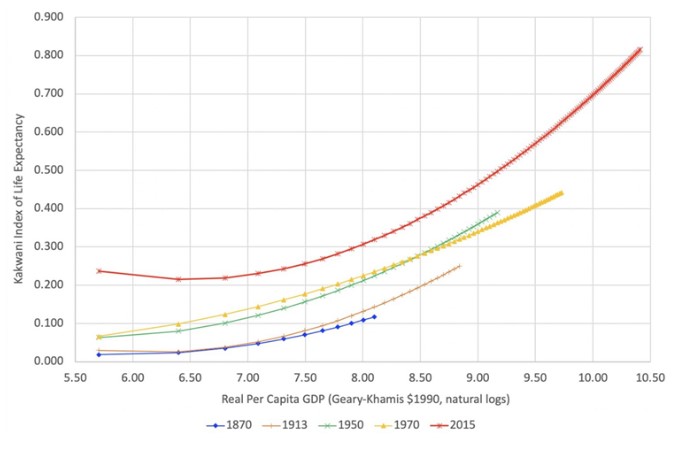
By Vincent Geloso


With the pandemic and the rise of climate alarmism, attacks on economic growth have multiplied. An increasingly larger set of pundits, academics, and politicians now embrace some variants of de-growth. They tie economic growth to a variety of “bad” outcomes. One of those “bads” is the idea that economic growth is not yielding many fruits in terms of better health outcomes – generally captured in the all-encompassing statistic of life expectancy at birth.
To make this claim, they (sometimes unknowingly) rely on the “Preston Curve” – named after Samuel Preston in a famous article in Demography. To visualize the curve, imagine a graph where life expectancy is depicted on the vertical axis and income is depicted on the horizontal axis. The line that draws the relation between both variables shows that for each additional increment in income, the associated increase in life expectancy is less than the previous increment. This phenomenon reflects the law of diminishing marginal returns. However, once a certain point is reached, there are no gains to be had. The curve is essentially a flat line after that point.
From this, the inference made by many de-growthers is that we do not need more income than a certain fixed level. Anything beyond that brings little fruits and many harms.
This is a bad inference, however, because they forget many things. The first is that when it was first drawn, back in the 1970s, there were few “exceptionally rich” countries to draw the Preston Curve. Today there are far more countries that are exceptionally wealthy as seen from the vantage point of the 1970s. Over time, the curve has moved up and right. This means that not only is each dollar now more effective at improving health than before, but each additional dollar is more effective than it was before. True, the effect of an additional dollar is less than the effect of the previous dollar of income, but the effect remains positive. As such, de-growthers are understating the fruits of economic growth.
Second, and far more importantly, the curve’s shape is somewhat unsurprising because of biological considerations. Indeed, a large number of deaths in low-income countries are tied to preventable diseases and malnutrition. The role of a “natural” boundary to life expectancy matters little in these situations. As such, extra income (which allows for better nutrition, better water quality, better health care, and the like) makes it easy to improve life expectancy when it is “below” the biological boundary. Once one is closer to the boundary, improvements are harder to secure. At least, they are harder to secure unless one pushes the boundary further. And yet, pushing back that boundary is exactly what economic growth allows. In a recent article in Economics & Human Biology, economic historian Leandro Prados de la Escosura pointed out that it is far more impressive to improve life expectancy by one extra year when the statistic stands at 85 years rather than at 45 years. This means that we should give more “weight” to an extra year near the top rather than an extra year closer to the bottom. When this is done, we observe a totally different Preston Curve. Rather than seeing diminishing marginal returns, we see increasing ones!


Source: de la Escosura, L. P. (2023). Health, income, and the Preston curve: A long view. Economics & Human Biology, 48, 101212.
Why would economic growth allow us to push the biological boundary in a way that explains de la Escosura’s finding? Consider, for example, the role of research and development (R&D) in biopharmaceuticals which explains a sizable share of the gains of gains in life expectancy at age 50, 60 and 65. That R&D is long and it is also immensely costly. Poor societies can ill-afford to spend time and resources on this type of activities. This is why we observe that R&D as a share of total gross domestic product increases is higher in richer countries than in poorer ones. Richer societies can dedicate resources more easily to pushing biological boundaries through R&D.
This means that there are no diminishing effects of income on our ability to secure equally difficult improvements in health outcomes. The wealthier we are, the easier it is to tackle the “hard” health issues. The de-growthers could not be more wrong – growth is healthy!
TELL YOUR FRIENDS ABOUT CITIZENS JOURNAL Please keep us publishing – DONATE




